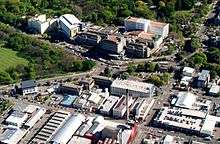District health board
District health boards (DHBs) in New Zealand are organisations established by the New Zealand Public Health and Disability Act 2000, responsible for ensuring the provision of health and disability services to populations within a defined geographical area. They have existed since 1 January 2001, when the Act came into force.[1] There are 20 DHBs (fifteen in the North Island and five in the South Island). Initially there were 21 DHBs, and this was reduced to the current 20 organisations in 2010. DHBs receive public funding from the Ministry of Health on behalf of the Crown, based on a formula which takes into account the total number, age, socio-economic status and ethnic mix of their population. DHBs are governed by boards, which are partially elected (as part of the triennial local elections) and partially appointed by the minister of Health.
.svg.png)
History
District health boards were first introduced as an idea in the 1970s in the Green and White Paper suggested by the then Labour government. This was part of a plan to nationalise primary health care as the Social Security Act of 1938 had originally intended. Labour subsequently lost the election to Robert Muldoon's National Party in the 1975 election. Muldoon's government chose however to slowly implement these reforms in trial "area health boards", which can be seen as early predecessors of the district health boards.
The more direct predecessors were the Crown health enterprises (CHEs) and subsequent Hospital and Health Services (HHS) management structures of the 1990s; these were responsible for managing the hospitals under business ethos, albeit, with the expectation that the former would return a profit to the shareholders (i.e. the government).
In the 1990s "regional health authorities" (RHAs) were formed. These RHAs were amalgamated in 1997 to form the Health Funding Authority (HFA). The election of the Labour-Alliance government in the 1999 election saw the New Zealand Public Health and Disability Act 2000 passed by parliament, this led to the merging of the HFA with the Ministry of Health. Part of the HFA's funding capacity combined with the hospital management elements of the Hospital and Health Services board to form the DHBs.
From their creation until 1 May 2010, there were 21 DHBs. At that date, Otago DHB and Southland DHB amalgamated their boards to form the new Southern DHB.[2]
Organisation

The Ministry of Health gives district health boards a set of objectives; they have a degree of autonomy in how they choose to achieve these. In contrast to their predecessors, the regional health authorities, the DHBs are non-profit providers. The DHB Funding and Performance Directorate of the Ministry of Health[3] monitors the performance of individual DHBs. DHBs provide funding to primary health organisations (PHOs).
DHB activities are governed by boards, which consist of up to eleven members: seven elected by the public every three years, and up to four appointed by the Government's Minister of Health. From 1 January 2001 the boards comprised appointed members only. The first elected members were chosen in the 2001 local-body elections held on 13 October using the first-past-the-post voting system (FPP).[4] Since the 2004 local-body elections, the single transferable vote (STV, a proportional voting system) has been used.[5] The use of appointed Board members aims to balance the boards' expertise as deemed necessary.[6] As part of the appointment process, the Minister of Health appoints a chairperson and a deputy-chair; either from the appointed members or from elected members. Voting for public-elected DHB board members occurs at the same time as local-body elections. Local-body elections take every three years on the second Saturday in October. As defined in the legislation, elected and appointed (if they get appointed in time) members start their term 58 days after the election (i.e. in early December) and the term of the previous board finishes that day.
Taranaki and Wairarapa District Health Boards maintain their own ambulance services, with St John and the Wellington Free Ambulance covering the rest of the country.[7]
On 1 May 2010 the Otago DHB and the Southland DHB merged to form a new Southern DHB, with elected members coming from two constituencies – Otago and Southland – and the remainder appointed by the Ministry of Health, with the change taking effect from the 2010 local-body elections. From 1 July 2010, a unified primary health organisation has covered the entire new Southern DHB region, with PHO centres in Alexandra, Dunedin and Invercargill with the mandate of providing PHO resources and services, replacing the previous nine PHOs.
Locations
There are 20 DHBs, organised around geographical areas, of varying population sizes, though they are not coterminous with the Regions of New Zealand:
See also
- Association of Salaried Medical Specialists, a trade union that represents just over 4000 senior salaried doctors and dentists, most of whom are employed by DHBs
- List of hospitals in New Zealand
References
- "District health boards". Ministry of Health. 12 February 2020. Retrieved 12 April 2020.
- Ryall, Tony. "New Southern DHB roles announced".
- DHB Funding and Performance Archived December 31, 2005, at the Wayback Machine
- "Editorial: Elected boards an unhealthy hybrid". The New Zealand Herald. 30 June 2000. Retrieved 8 January 2017.
- Choosing Electoral Systems in Local Government in New Zealand (PDF). STV Taskforce. May 2002. p. 27. ISBN 0-578-09275-X. Retrieved 2 May 2020.CS1 maint: ignored ISBN errors (link)
- DHB Elections Archived December 31, 2005, at the Wayback Machine from Ministry of Health, last updated 21 January 2005
- "Ambulance Communications Centres Today". NZ Government 111 website. Retrieved 20 February 2009.
- {cite web |url= https://www.health.govt.nz/new-zealand-health-system/my-dhb |title= Subnational population estimates at 30 June 2009: local government areas |publisher=Ministry of Health |accessdate= 10 June 2020}. My DHB.